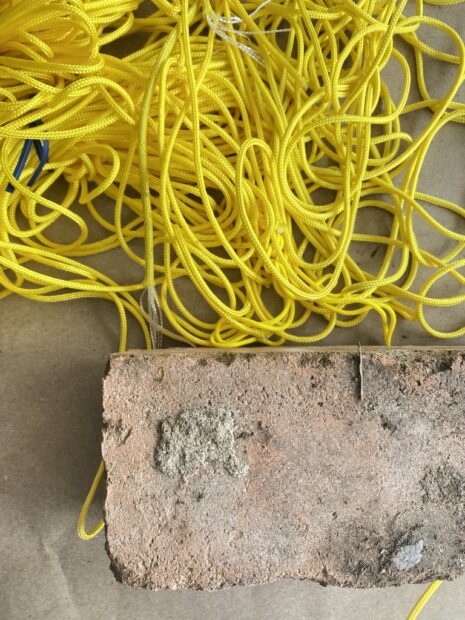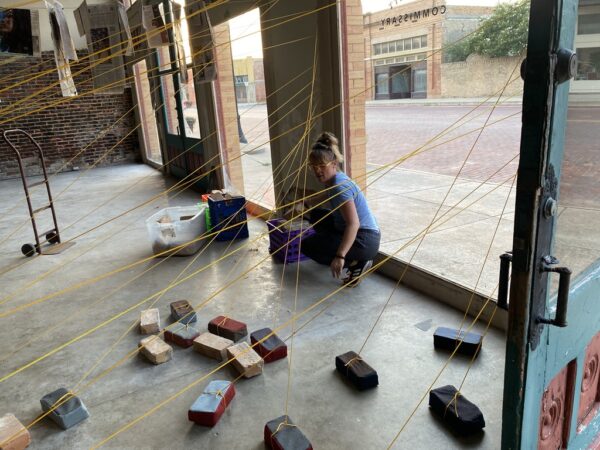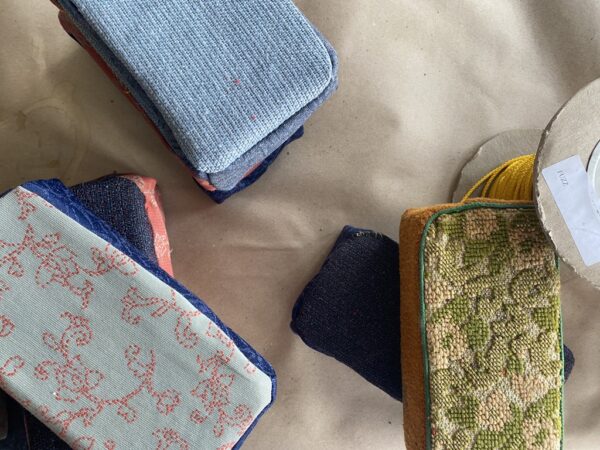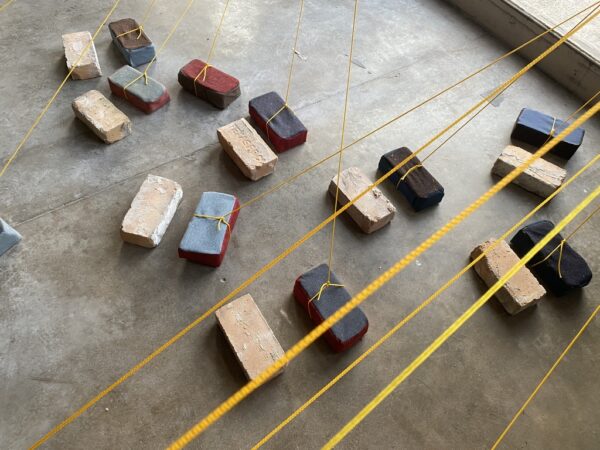For earlier installments in this series, please start here. The most recent installment (before this one) is here.
I have known Jade Walker for a long time. She advocated for me on a massive project while she was Director at the Visual Art Center at UT Austin in 2016. We worked together on a site-specific installation in Austin’s Facebook offices in 2020. I watched as she tackled the Art City art fair the year Austin suffered major thunderstorms, and sent a sculpture of large white inflatable balls flying in every direction around the Long Center. Through it all I have always admired Jade’s ability to find humor in any situation without compromising her professional tenacity.
But this was the first time I had the opportunity to witness Jade work on a much larger scale. While the Facebook project was big and site-specific, it didn’t take up an entire building.
And in Bartlett we have space — and we have a very specific type of space, one that holds so many memories for residents, and one that has been closed off and decaying for decades. In Bartlett we have a building with a fading memory.
I wanted Jade to come in and work her magic with site specificity. Her installations and sculptures become prominent, three-dimensional weavings in space that rely on the quirks of surrounding architecture. The ways Jade works with inanimate space and architecture is akin to how others work as social practitioners; she is sensitive to space, sensitive to the stories it can tell, and sensitive to who has access to it and when.
This time around, for Jade Walker in Bartlett, the memory is architectural within the physical building itself, and is literally highlighted with yellow string and nearly 100 historical bricks encircling two windows.
Leslie Moody Castro: What interested you about the Bartlett Project when I approached you with it?
Jade Walker: I am always thrilled to make art alongside the bones of old spaces that hold a history and generally fall out of the standard white-cube norms. I have enjoyed making site-specific work in places like Elsewhere, a residency in South Carolina, and am now working on an exhibition in the historic Elisabet Ney Museum in Austin. The challenge and content that is built into an alternative space allows my work to respond and accentuate nuances of a history. This history can shape color or material response along with content. The Bartlett Project provided a space and a jumping-off point for a historical “deep dive” that caught me right away. I also love storefront windows and have been working through ideas of what is considered inside and out, and how entry is both marked and granted.
Right away, there was also the lingering question from many of us on this project: “Who is this artwork for?” Will the people of Bartlett find joy in having outside artists translate the workings of their town or not? Is the work going to include their voices and how? Sharing art with and for a town that does not have any formal art spaces is both enticing and also a big responsibility. It felt like an opportunity to stretch my practice. Finally, I was curious how my work would fit into the exhibition with artists that were more seasoned in the practice of social engagement and practice.
LMC: What were you looking forward to most in the beginning?
JW: Before I spent time in Bartlett, it was just the building that drew me in. The tall ceilings and lovely facade along with the brick road and woodwork all called for art. I had just finished an art residency at the shiny new Facebook offices in Austin. In that case, I was creating work for their employees solely and they were a captive audience. That installation was inspired by notions of comfort and injury, and happened right as the pandemic broke out.
The idea of making work for a completely different demographic in a small town was very far from this, and a stark difference to the polished white walls of a tech office in bustling downtown Austin. I was also interested in working with a group of artists in which social engagement was first and foremost in their practice. In the last few years, I have slowly begun to shift my practice to include the community. At first, this was asking friends to be involved by contributing objects for an installation or to share thoughts on a subject, but more and more, I found the work leaned toward collaboration. I welcomed the idea of seeing this practice in another artist’s studio firsthand. I have found the outreach by the other artists in the exhibition to be generous and thoughtful and the inclusion to be deep and meaningful. The connection Aimée Everett formed with the families of color she interviewed has revealed a town still facing issues of inequality. M.E. Laursen along with Mark Menjivar have captured the voices and stories of the next generation in Bartlett and gone on a step further to share art experiences in the Bartlett Independent School District. Witnessing their commitment has been very rewarding.
LMC: What was your initial idea for the project/exhibition?
JW: For some time I have been working on a series of outdoor sculptures that are installed in signage structures. The first one is titled Not, at Canopy in Austin, and another is Mire + Mend at the Elisabet Ney Museum [in Austin]. In this series, I am investigating new types of accessible communication, subtracting words, and adding colors and traditional weaves in its place.
When I visited Bartlett the first time, the abandoned sign structures were so perfect for an extension of this series. Historical images of the town in black and white drew me towards adding color to outdoor structures of the buildings. It felt promising to call attention to the street and invite people to reclaim it. After being in Bartlett, I realized the piece really needed to do more than be an outdoor wayfinder. The street and its nostalgic appeal was already being noticed. I wanted this work to hold space for dialogue and make invitations. I needed to hold the door open.
LMC: What have you learned along the way?
JW: I have learned to trust my gut in the studio in new ways. At first, I was not confident how my voice fit into the space of Bartlett. I grew up in a large city and have been fortunate to have the privileges that many middle-class, white Americans take for granted. I have chosen to make Austin my home which again allows for the ability to surround myself with many people, institutions, and opportunities different from small-town living.
After moving through several ideas, the symbol of a door and the essence of a placeholder/doorstop/wedge/threshold to mark the entrance became solid, and my instinct to start from this jumping off point felt right. I crafted the work to be seen from the windows when the space was not open for viewing and I sourced stories and materials from Kathy Jones, longtime resident, shop owner and caretaker of the Bartlett Activities Center. She shared memories of the past that helped shape my installation.
I pared down in new ways and restricted myself to gather the materials from the few blocks that made up the downtown. The switch in my normal artist practice came with Kathy’s involvement in making material choices and my attempt to infuse the work with her stories. For that plunge, I am grateful. I have also learned a lot about making work without an established art institution present to act as a conduit for artists learning in a community. This is a difficult task and takes time and trust.
As Bartlett changes, I am hoping that there will be a melting of longtime residents and transplant artists and dreamers that work together to craft the way art can play active roles in Bartlett.
LMC: Has the nature of your work changed through the process?
JW: This year, my work has grown in so many ways, and with new threads of important issues as almost every artist I know. There is no way for me to discount issues of racial injustice, the demise of our environment, isolation from the pandemic, and the political divide in our country that is haunting. And I would not want to. They are finding roots in my practice and empowering my voice as an artist to help make change.
In fact, I have pulled more out of my practice this year than any year before this. It is hard to separate how much of this year in general has changed my studio practice (and me as an artist, parent, and human being) and how much of that change has been working in Bartlett. My fellow artists on this project have helped me to see new vantage points that I am grateful for. The town and its history, plus its current socioeconomic position, has helped me to consider audience, art accessibility and the general building blocks of community in new ways. I have more confidence in translating real life experience into my practice.
As I move into a new set of projects, I feel ready to share my ideas, equipped with new tools. On the flip side, I am more cautious about how artists can and should impact communities and how that should be done in towns in the process of being revitalized. Seems like there is a ton more to unpack for me as the project continues to evolve.
****
To learn more about Bartlett, please follow @downtownbartlett. For more on ICOSA Collective follow @icosa_art. Next installment: Two weeks.









